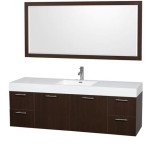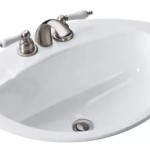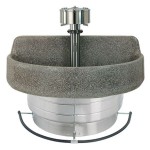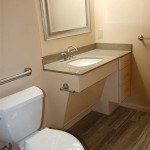Parts of a Bathroom Sink Drain: A Comprehensive Guide
The bathroom sink drain, often overlooked, is a crucial component of any bathroom plumbing system. It's responsible for channeling wastewater away from the sink and into the drainpipes, preventing overflows and maintaining hygiene. Understanding the individual parts of a bathroom sink drain, their functions, and how they interact is essential for homeowners, plumbers, and anyone interested in basic plumbing maintenance and repair. This article provides a detailed overview of the various parts that constitute a standard bathroom sink drain assembly.
The Sink Tailpiece: The Initial Path of Drainage
The tailpiece is the initial section of the drain located directly beneath the sink drain opening. Typically made of metal (brass, chrome-plated brass, or stainless steel) or PVC plastic, the tailpiece is a straight, cylindrical pipe that extends downward from the sink drain. Its primary function is to create a straight, unobstructed pathway for water to flow from the sink basin into the subsequent drain components.
The length of the tailpiece can vary depending on the sink's design and the position of the drainpipe within the wall. In situations where the drainpipe is positioned lower than the standard height, a longer tailpiece might be necessary. Conversely, if the drainpipe is located higher, a shorter tailpiece will suffice. It’s critical to ensure the tailpiece length aligns with the installation requirements to prevent strain on the connecting plumbing components and potential leaks.
The tailpiece is connected to the sink drain opening via a flange and a strainer (discussed later). The connection is usually secured with a slip nut and a washer, creating a watertight seal to prevent water from leaking around the drain opening. At the bottom of the tailpiece, another slip nut and washer are used to connect it to the trap, specifically the P-trap.
The Sink Flange and Strainer: Preventing Debris from Entering the Drain
The sink flange and strainer work together to form the visible part of the drain within the sink basin. The flange is a circular, often decorative piece that sits flush against the sink's surface around the drain opening. It provides a finished look while also serving as a base for the strainer.
The strainer, typically made of metal or plastic, is designed to prevent large debris, hair, and other solid objects from entering the drainpipe. These items can accumulate over time and cause clogs within the drain system, leading to slow drainage or complete blockages. Strainers come in various designs, some with small holes that allow water to pass through while trapping debris, and others with a basket-like structure that catches larger items. The choice of strainer depends on the user's preference and the likelihood of specific types of debris entering the drain.
The flange is connected to the sink drain opening using plumbers putty or a silicone sealant to create a watertight seal. The strainer is then inserted into the flange and often secured with a screw or a similar mechanism. Regular cleaning of the strainer is essential to maintain proper drainage and prevent clogs. This involves removing the strainer and clearing any accumulated debris.
The P-Trap: Blocking Sewer Gases
The P-trap is a curved section of pipe located beneath the sink, designed to hold a small amount of water at all times. This trapped water serves as a barrier, preventing sewer gases from backing up into the bathroom through the drain opening. Sewer gases contain methane, hydrogen sulfide, and other potentially harmful and unpleasant-smelling compounds.
The P-trap consists of three main sections: the inlet arm (connected to the tailpiece), the U-bend (the curved section), and the outlet arm (connected to the drainpipe within the wall). The inlet arm receives wastewater from the tailpiece. The U-bend is where the water is trapped, creating the gas barrier. The outlet arm directs the water away from the trap and into the drainpipe.
P-traps are typically made of PVC plastic or metal, such as chrome-plated brass. They are typically connected using slip nuts and washers, allowing for easy removal and cleaning. Periodically, the P-trap may need to be disassembled to remove accumulated debris or clogs. This is a relatively simple process involving loosening the slip nuts and carefully removing the trap to clear any blockages.
The Drainpipe: Connecting to the Plumbing System
The drainpipe, also known as the waste pipe, is the pipe that connects the P-trap to the main plumbing system within the house. It’s usually a larger diameter pipe than the tailpiece and P-trap, allowing for efficient removal of wastewater. Drainpipes are typically made of PVC plastic, copper, or galvanized steel, depending on the age of the plumbing system and local building codes.
The drainpipe is connected to the outlet arm of the P-trap using a slip nut and washer. The other end of the drainpipe connects to a larger drain line within the wall or floor, which eventually leads to the main sewer line. The connection between the drainpipe and the larger drain line is crucial for ensuring proper drainage and preventing leaks.
The drainpipe may include additional fittings, such as elbows or tees, to accommodate the layout of the plumbing system. Proper installation of the drainpipe is essential for maintaining a functional and leak-free drainage system. Any leaks in the drainpipe can lead to water damage and potential mold growth.
The Pop-Up Drain Assembly: Controlling Water Retention
Many modern bathroom sinks incorporate a pop-up drain assembly, which allows the user to easily open and close the drain using a lever or knob. This feature is particularly useful for filling the sink with water for washing or shaving. The pop-up drain assembly consists of several interconnected parts that work together to control the drain's opening and closing mechanism.
The main components of the pop-up drain assembly include: the drain stopper (also known as the pop-up plug), the pivot rod, the lift rod, and the clevis. The drain stopper sits within the sink drain opening and seals the drain when closed. The pivot rod is a horizontal rod that connects to the drain stopper and is controlled by the lift rod. The lift rod is the vertical rod that extends from the sink faucet and is used to raise and lower the drain stopper. The clevis is a small connector that links the lift rod to the pivot rod.
When the lift rod is raised, it moves the clevis, which in turn rotates the pivot rod. This rotation raises the drain stopper, opening the drain and allowing water to flow out. When the lift rod is lowered, the opposite action occurs, closing the drain and retaining water in the sink. The pop-up drain assembly is typically made of metal or plastic and requires periodic maintenance to ensure smooth operation.
Washers and Nuts: Ensuring Watertight Seals
Throughout the bathroom sink drain assembly, washers and nuts play a critical role in creating watertight seals between the various components. These small but essential parts prevent water from leaking around the connections, ensuring that all wastewater is properly channeled through the drain system.
Washers are typically made of rubber, neoprene, or plastic and are placed between the connecting surfaces of the drain components. When the nuts are tightened, the washers compress, creating a tight seal that prevents water from escaping. Different types of washers are used in different locations within the drain assembly, depending on the specific requirements of the connection.
Nuts, often referred to as slip nuts, are used to secure the connections between the drain components. They are typically made of metal or plastic and are designed to be easily tightened and loosened using a wrench or pliers. Over-tightening the nuts can damage the washers and the drain components, while under-tightening can result in leaks. It’s important to find the right balance when tightening the nuts to ensure a proper seal without causing damage.
Regular inspection of the washers and nuts is essential to identify any signs of wear or damage. Replacing worn or damaged washers and nuts can prevent leaks and maintain the integrity of the drain system. When disassembling the drain assembly for cleaning or repair, it’s always a good idea to inspect the washers and nuts and replace them if necessary.
Specialized Tools for Drain Maintenance and Repair
While some tasks related to bathroom sink drain maintenance can be accomplished with basic tools, certain specialized tools are helpful, and sometimes necessary, for effective drain repair and maintenance. These tools can simplify the process and help prevent damage to the plumbing components.
A basin wrench, also known as a sink wrench, is a specialized wrench designed for loosening and tightening nuts in hard-to-reach places, such as under the sink. Its long handle and swivel head allow for easy access to the nuts on the tailpiece and P-trap. A plumber's wrench, adjustable pliers, or channel-lock pliers are also useful for gripping and turning nuts and pipes.
A plumber's snake, or drain snake, is a flexible tool used to clear clogs in drainpipes. It consists of a long, flexible cable with a corkscrew or auger at the end. The snake is inserted into the drainpipe and rotated to break up or remove any blockages. For more stubborn clogs, a motorized drain snake may be necessary.
Plumbers putty or silicone sealant is used to create watertight seals around the sink flange and other connections. It’s important to choose a sealant that is compatible with the materials of the drain components. Teflon tape, also known as PTFE tape, can be used to seal threaded connections and prevent leaks.
In addition to these tools, a bucket, rags, and gloves are essential for protecting yourself and your workspace during drain maintenance and repair. Proper ventilation is also important, especially when working with chemicals or drain cleaners.
Understanding the parts of a bathroom sink drain and how they function is crucial for maintaining a functional and efficient plumbing system. Regular inspection, cleaning, and prompt repair of any issues can prevent costly problems and ensure the longevity of the drain assembly.

20 Bathroom Sink Drain Parts How They Works Stopper Plumbing

Bathroom Sink Plumbing Diagram Diy Sinks Drain Kitchen Remodel

How To Fit A Bathroom Sink Diy Guides Victorian Plumbing
How To Install Bathroom Sink Drain Queen Bee Of Honey Dos

Bathroom Sink Parts Diagram Plumbing Drain Kitchen Remodel

Bathroom Sink Plumbing

Parts Of A Sink The Home Depot

Bathroom Sink Popup And Stopper Problems

Bathroom Sink Pop Up Stopper Parts Diagram Drain Plug

How To Replace Bathroom Sink Stopper Avg Cost 25 65 1 2hrs
Related Posts







